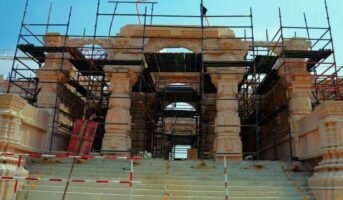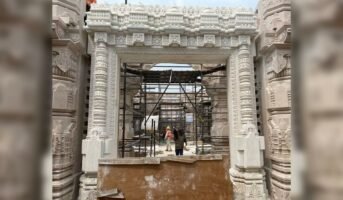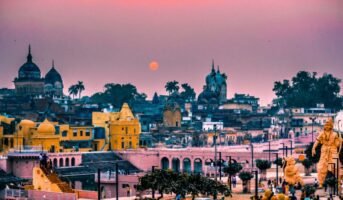The Ayodhya Ram Temple opened for general public on January 23, 2024, after the Pran-Pratishtha (consecration) ceremony performed in the presence of prime minister Narendra Modi. The idol of Ram Lalla at the Ayodhya Ram Janmbhoomi Mandir was installed in the sanctum- sanctorum (garbha-griha) of the temple on January 22, 2024.
Ayodhya Ram Mandir: Timeline
| 1528-1529: Mughal emperor Babur builds Babri Masjid
1850s: Start of communal violence over the land 1949: Ram Idol found inside the mosque, intensifying communal tension 1950: Two suits filed in Faizabad civil court seeking permission to worship the idol 1961: UP Sunni Central Wakf Board demands the removal of the idol 1986: District Court opens the site for Hindu worshippers 1992: Babri masjid demolished on December 6 2010: Allahabad HC rules three-way division of disputed area among Sunni Waqf Board, Nirmohi Akhara and Ram Lalla 2011: SC stays Allahabad HC order 2016: Subramanian Swamy files plea in SC, seeks the construction of Ram Temple 2019: SC accepts Ayodhya was the birthplace of Lord Ram, hands over the entire 2.77 acres of disputed land to the trust and orders the government to give 5-acre land to Sunni Waqf Board as an alternate site 2020: PM Modi performs Bhumi Poojan and lays the foundation stone |
Ayodhya Ramjanmbhoomi Mandir: Key facts
| Architecture | Nagara style of architecture |
| Agency overseeing construction | Shri Ram Janmabhoomi Teerth Kshetra Trust |
| Builders | Larsen & Toubro, Tata Consultancy Services |
| Designer | Chandrakant Bhai Sompura |
| Year of completion | 2024 |
| Date of inauguration | 22 January 2024 |
| Area | 2.7 acre |
| Foundation | 14-metre-thick |
| Plinth | 21-foot-high |
| Stories | 3 |
| Length | 380 foot |
| Width | 235 foot |
| Height | 161 foot |
| Materials used in temple |
|
| Number of mandapas (halls) | 5 |
| Name of mandapas | Nritya Mandap, Rang Mandap, Sabha Mandap, Prathana Mandap, Kirtan Mandap |
| Number of pillars | 392 |
| Number of doors | 44 |
| Size of new Ram Lalla idol | 51 inch |
| Material used for Ram Lalla idol | Black stone |
| Designer of Ram Lalla idol | Arun Yogiraj |
| Estimated cost | Between Rs 1,400 crore to Rs 1,800 crore |
Ayodhya Ram Janmbhoomi Mandir: Background
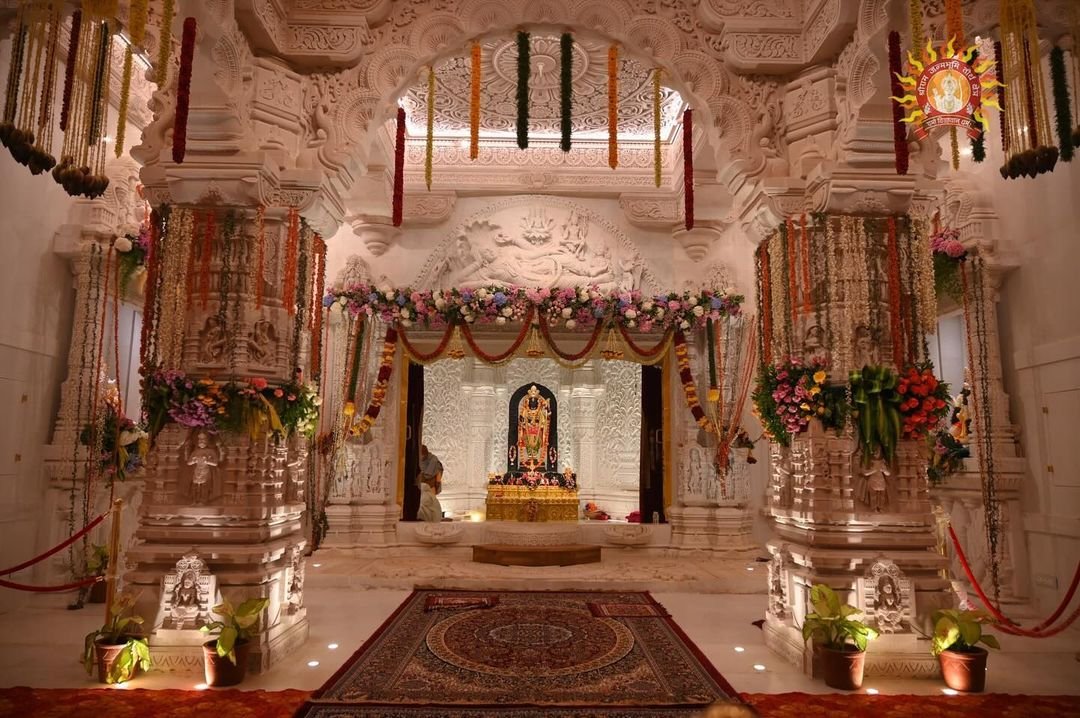
One of the biggest temples to be built in India after Independence, the Ayodhya Ram Temple is touted to be a combination of new-age technological conveniences and age-old Indian traditions.
Between 1528 and 1529, the Babri Masjid was built by the Mughal emperor Babur. However, members of the Hindu community also sought possession of the site, claiming it to be the birthplace of Lord Ram. The site subsequently became a disputed site and a long, legal battle ensued. Ending the title dispute on November 9, 2019, the Supreme Court accepted the 2.77 acres of disputed location as the birthplace of Lord Ram, paving the way for the construction of the Ram Mandir.
Ayodhya Ram Mandir: Foundation laying ceremony
After the SC verdict, prime minister Narendra Modi performed the Bhumi Poojan ceremony on August 5, 2020, and laid the foundation stone of the temple.
See also: All about Ayodhya Airport
Ayodhya Ram Janmbhoomi Temple area and capacity
Spanning 54,700 sq ft, the temple area covers nearly 2.7 acre of land. The entire Ram Mandir Complex would be spread over nearly 70 acre and will be equipped to host about a million devotees at any time.
Ayodhya Ram Temple: Agency overseeing construction
The Shri Ram Janmabhoomi Teerth Kshetra Trust is supervising the temple’s construction.
Ayodhya Mandir: Estimated cost and funding
The temple is built at an estimated cost of Rs 1,800 crore. The temple trust is received between Rs 60-70 lakh in donations earlier for building the grand temple, officials of the Ram Janmabhoomi Teerth Kshetra Nyas said.
Ayodhya Ram Mandir: Building material
The foundation of the temple is constructed with a 14-metre- thick layer of roller-compacted concrete (RCC), giving it the appearance of artificial rock. No iron is used anywhere in the construction. For protection against ground moisture, a 21-foot-high plinth has been constructed with granite.
The core of the temple is built using pristine white Rajasthan Makrana marble. Karnataka’s Charmouthi sandstone has been used to carve out the exquisite idols of the deities. On the other hand, pink sandstone from Rajasthan’s Bansi Paharpur has been used in entrance gate’s imposing figures. Black stone used for Lord Ram’s idol originates from Karnataka. From the Himalayan foothills, Arunachal Pradesh and Tripura have offered intricately carved wooden doors and handcrafted fabrics, standing as gateways to the divine realm. Brassware hails from Uttar Pradesh, while polished teakwood has been sourced from Maharashtra.
Built using India’s traditional and indigenous technology, the temple complex has a sewage treatment plant, water treatment plant, water supply for fire safety and an independent power station.
Bansi Paharpur sandstone
The superstructure of the Ram Mandir will be made of carved Rajasthan Bansi Paharpur stone, the rare pink marble stones, world-renowned for its beauty and strength. It will require a total of 4 lakh sq ft of stone.
The Bansi Paharpur Sandstone is found in the Bayana Tehsil of Bharatpur District in Rajasthan and it is available in hues of pink and red. The centre, in 2021, gave an in-principal approval to convert 398 hectares of protected forest land into revenue land to allow the mining of the pink sandstone in the vicinity of the Band Baretha Wildlife Sanctuary in Bharatpur, reversing the ban on mining put in place in 2016.
The Bansi Pahadpur Sandstone has been used in various grand structures of the country, including the Akshardham Temple, the Parliament Complex and the Lal Quila of Agra. Steel or bricks would not be used in the construction of the Ram Mandir.
Also read: Ayodhya: Temple town turns into a property hotspot
Makrana marble
Marble from Makrana in Rajasthan Makrana is a metamorphic rock found in a single deposit in India. It has a range of about 90–98% calcium carbonate. It is found only in Makrana. Characterised by its bright white color with intricate grey or black veining, this marble is world-renowned for its exceptional purity and aesthetic appeal. It is Asia’s first Global Heritage Stone Resource (GHSR), according the International Union of Geological Sciences (IUGS). The Makrana marble is the first stone resource from India and Asia to get the GHSR status in July 2019. The spectacular marble has been used to build forts, palaces and archaeologically significant buildings in India and abroad. Some of the iconic buildings constructed using the Makrana Marble include the Taj Mahal, the Victoria Memorial in Kolkata, the interiors of Red Fort of Delhi as well Agra, etc.
Ayodhya Ram Mandir: Builders
While Larsen & Toubro are responsible for building the main structure, Tata Consultancy Engineers Ltd would develop the allied facilities.
Ayodhya Ram Mandir: Interior
Specifications
The upcoming temple is 380-foot long, 235-foot wide and 161-foot high. In height, the temple will three times the height of existing structure n the old city.
Style
The temple is designed by chief architect, Chandrakant Bhai Sompura, whose grandfather, Prabhakarji Sompura, had designed the Somnath Temple, along with his son, Ashish Sompura. The 79-year-old architect was appointed in 1992. Sompura mentioned that the Ram Mandir is being built in the Nagara style, following the principles of Vastu Shastra. The entrance on the east would be built in the Gopuram style, which represents the temples of the south. The walls of the temple would display artworks depicting the life of Lord Ram.
Shape
The sanctorum of the mandir would be octagonal-shaped while the structure perimeter would be circular.
Floors
The mandir will have five domes and one tower with a height of 161 ft. The 3-floor temple will have a centre – Garbh Griha – built to allow sun rays to fall on the idol of Ram Lalla, the infant embodiment of the Lord. Like the sanctorum, the Griha Mandap would be fully covered, while the Keertan Mandap, the Nritya Mandap, the Rang Mandap and the two Prarthana Mandaps on each side would be open areas.
Ram Lalla idol
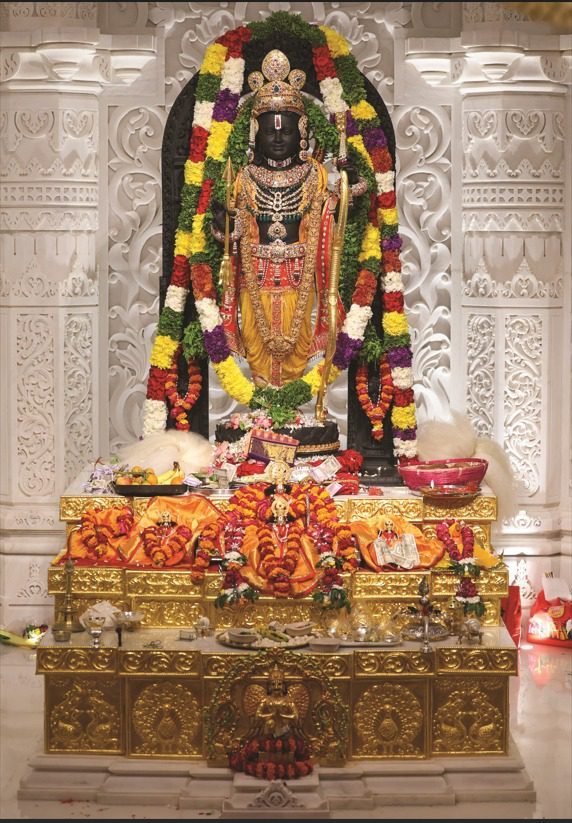
(Source: Twitter handle of Amit Shah)
There are two idols of Lord Ram at the sanctum- sanatorium (garbha griha) of the Ayodhya Ram Mandir. One is the actual idol found in 1949, and has been in the tent for decades. The other is a new one sculpted by Arun Yogiraj. The new idol made of Lord Shri Ram Lalla is in the form of a five-year-old child, hence the name Balak Ram. The 51-inch statue is made of black stone procured from Karnataka. Both the idols are placed at the ground floor of the three-storey temple.
Ram Lalla idol shringaar
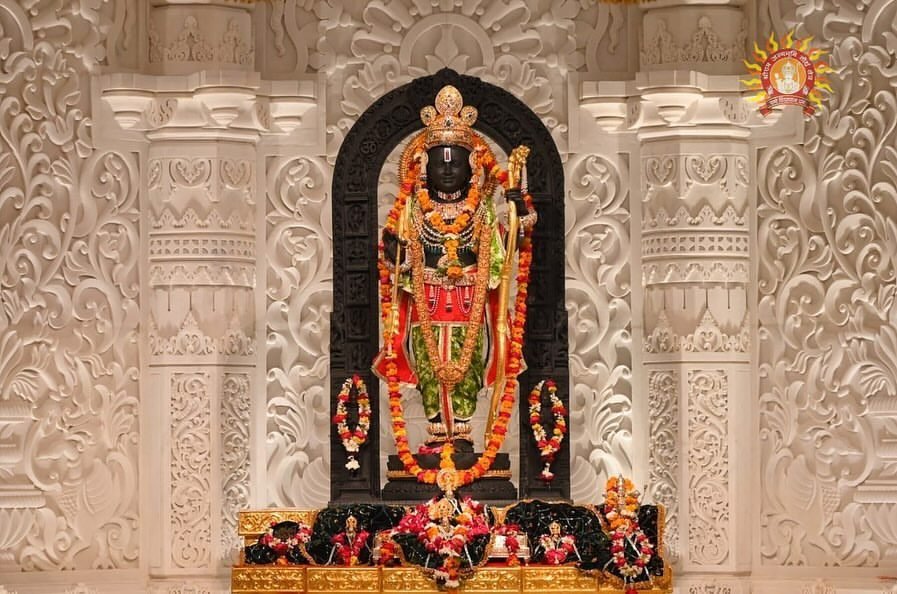
According to the Shri Ram Janmbhoomi Teerth Kshetra Trust, various ornaments have been used to adorn Ram Lalla idol “based on extensive research and study following the descriptions of Shri Ram’s scripturally appropriate splendour in texts such as the Adhyatma Ramayana, Valmiki Ramayana, Ramcharitmanas, and Alavandar Stotra”. “Following this research, and as per concept and direction of Shri Yatindra Mishra, these ornaments have been crafted by Shri Ankur Anand’s institution, Harsahaimal Shiamlal Jewellers, Lucknow.
Yellow angavastram, red pataka
The shyamvarna idol is adorned in Banarasi fabric, featuring a yellow dhoti and a red pataka/angavastram. These angavastrams are embellished with pure gold zari and threads, featuring auspicious Vaishnav symbols, Shankh, Padma, Chakra and Mayur. These garments were created by Delhi’s textile designer, Manish Tripathi.
Mukut
The gold crown is embedded with rubies, emeralds and diamonds. Crafted in North Indian tradition, the mukut features an emblem of the Sun God. On the right side of the crown, strands of pearls are woven.
Tilak
The forehead of the idol is created with diamonds and rubies.
Kundal
Designed to complement the crown, the kundal (earrings) follows the same design pattern with peacock motifs. This piece of jewellery is embellished with gold, diamonds, rubies and emerald.
Kantha
The idol is adorned with a crescent-shaped necklace, studded with gems. It features floral designs symbolising good fortune, with an image of Surya Dev at the centre.
Kaustubh Mani
The heart of the idol is adorned with Kaustubh Mani, decorated with large ruby and diamonds. According to the spiritual tradition, Lord Vishnu and all his avatars wear the Kaustubh Mani on their heart.
Padika
This is a five-layered necklace, made of diamonds and emeralds, fearing an ornate pendant.
Vijayamala
This is the longest necklace the Lord is wearing. The gold necklace studded with rubies has symbols of Vaishnava tradition, the Sudarshana chakra, a lotus, a shankh and the mangal kalash.
Kanchi/Kardhani
Adorning the waist of the Lord is the gold Kardhani (waistband), studded with diamonds, rubies, pearls and emeralds. It also features small bells.
Bajuband
The arms are adorned with gold armlets, featuring precious stones.
Kangan
The gold bangles are also gem studded.
Mudrika
The rings on the fingers are also studded with gems and dangling pearls.
Gold bow in left hand
In his left hand, the 5-year-old Ram idol holds a bow made of gold and studded with pearl, rubies and emerald.
Paijaniya
Gem-studded anklets and toe rings adorn the feet and toenails of the Lord.
Golden umbrella
A resplendent umbrella is set over the Lord’s halo.
Toys for Ram Lalla
Toys made of silver have been kept close to the idol. These toys include a rattle, an elephant, a horse, a camel, a toy cart, and a spinning top.
The temple bell and Nagada
Gujarat has gifted a majestic 2,100-kg Ashtadhatu bell. Alongside, Gujarat also presents a 700-kg chariot carrying a special nagada crafted by the All India Darbar Samaj.
Doors and window
To build the windows and doors, Teak wood (Sagwan) has been procured from Maharashtra’s Chandrapur. Not an ordinary wood, Teak has a life span of over 100 years.
Ayodhya Ram Mandir: Lifespan
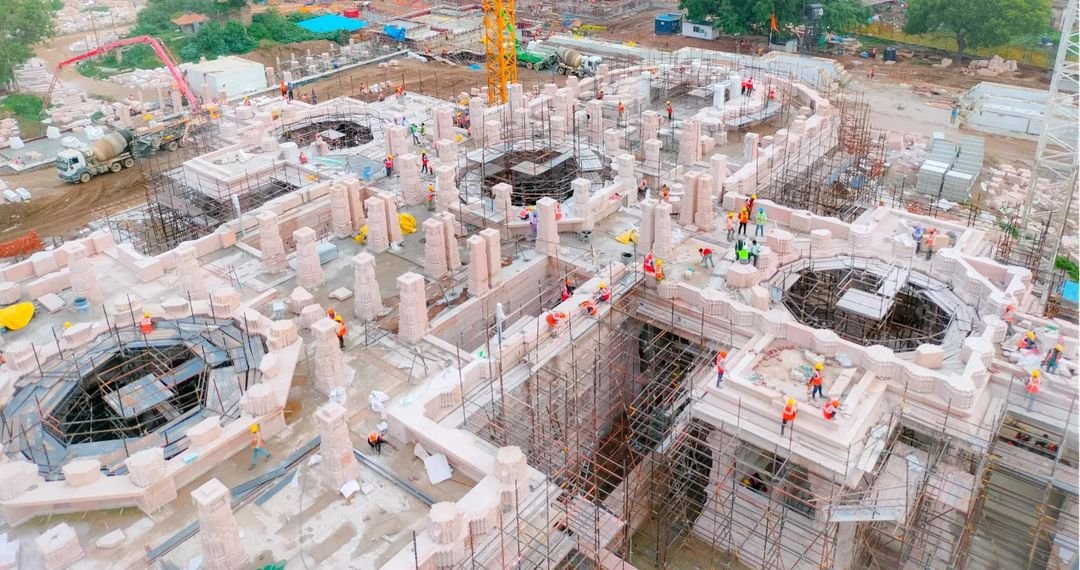
The grand structure is being built to have a lifespan of over 1,000 years. “Each material, which is being used…each design and drawing that is being used…is being done in IIT Chennai. They are the initiators. That is then tested by L&T and TCE. Finally, we have given the stability test for this agenda of 1,000 years to the Central Research Building Institute. The CRBI has tested the entire load that will come onto the structure through simulations. In short, we are dependent on the best brains of this country. There is just one objective – how to make this temple durable for 1,000 years and unique,” Nripendra Misra, the chairman of the Shri Ram Janmabhoomi Teerth Kshetra Trust’s temple construction committee, said.
Number of pilgrims to Ayodhya Ram Mandir
Earlier, over 50,000 people visited the temple every day. This number has increase to 100,000 after the temple was inaugurated .
Ayodhya Ram Mandir Darshan timing 2024
| Day | Timing |
| Sunday | 7:00 AM to 11:30 AM
2:00 PM to 7:00 PM
|
| Monday | 7:00 AM to 11:30 AM
2:00 PM to 7:00 PM
|
| Tuesday | 7:00 AM to 11:30 AM
2:00 PM to 7:00 PM
|
| Wednesday | 7:00 AM to 11:30 AM
2:00 PM to 7:00 PM
|
| Thursday | 7:00 AM to 11:30 AM
2:00 PM to 7:00 PM
|
| Friday | 7:00 AM to 11:30 AM
2:00 PM to 7:00 PM
|
| Saturday | 7:00 AM to 11:30 AM
2:00 PM to 7:00 PM
|
Ayodhya Ram Mandir Mangla Aarti timing
| Day | Timing |
| Sunday | 7 AM |
| Monday | 7 AM |
| Tuesday | 7 AM |
| Wednesday | 7 AM |
| Thursday | 7 AM |
| Friday | 7 AM |
| Saturday | 7 AM |
Ayodhya Ram Mandir Morning Aarti (Shiringar Aarti) timing
| Day | Timing |
| Sunday | 6:30 AM |
| Monday | 6:30 AM |
| Tuesday | 6:30 AM |
| Wednesday | 6:30 AM |
| Thursday | 6:30 AM |
| Friday | 6:30 AM |
| Saturday | 6:30 AM |
Ayodhya Ram Mandir Evening Aarti (Sandhya Aarti) timing
| Day | Timing |
| Sunday | 7:30 PM |
| Monday | 7:30 PM |
| Tuesday | 7:30 PM |
| Wednesday | 7:30 PM |
| Thursday | 7:30 PM |
| Friday | 7:30 PM |
| Saturday | 7:30 PM |
Ayodhya Ram Mandir Ratri Bhog Aarti timing
| Day | Timing |
| Sunday | 9 PM |
| Monday | 9 PM |
| Tuesday | 9 PM |
| Wednesday | 9 PM |
| Thursday | 9 PM |
| Friday | 9 PM |
| Saturday | 9 PM |
Ayodhya Ram Mandir Shayan Aarti timing
| Day | Timing |
| Sunday | 10 PM |
| Monday | 10 PM |
| Tuesday | 10 PM |
| Wednesday | 10 PM |
| Thursday | 10 PM |
| Friday | 10 PM |
| Saturday | 10 PM |
List of items not allowed in Ayodhya Ram Mandir
- Mobile phone
- Footwear
- Purse
- Flowers
- Garlands
- Prasad
Is there a fee for entry in the Ayodhya Ram Mandir?
No, there is no fee for entry in the Ayodhya Ram Mandir.
How to reach Ayodhya?
By Air: You can book flights to the Ayodhya Airport from every major Indian city. The airport is conveniently connected to the city centre through the modes of taxi and auto rickshaws.
By Road: Ayodhya is well-connected by road to nearby cities and towns. You can hire a taxi or use public transportation like buses to reach Ayodhya from nearby locations. The airport is located approximately 8-10 km from the city centre.
By Train: The nearest major railway station to Ayodhya is the Ayodhya Junction. From there, you can take a taxi or an auto-rickshaw to reach Ayodhya Airport. The distance is around 6-8 km.
Indian Railways has also launched Aastha Specials trains, connecting 66 locations across India to facilitate pilgrimage to Ayodhya. The connectivity boost is meant to boost travel in the north Indian city following the inauguration of the temple. Each train will have 22 coaches.
Aastha Special Train routes
Delhi
New Delhi Station – Ayodhya – New Delhi Station
Anand Vihar – Ayodhya – Anand Vihar
Nizamuddin – Ayodhya – Nizamuddin
Old Delhi Railway Station – Ayodhya Dham – Old Delhi Railway Station
Maharashtra
Mumbai – Ayodhya – Mumbai
Nagpur – Ayodhya – Nagpur
Pune – Ayodhya – Pune
Wardha – Ayodhya – Wardha
Jalna – Ayodhya – Jalna
Goa – Ayodhya -Goa
Telangana
Secunderabad – Ayodhya – Secunderabad
Kazipet Jn – Ayodhya – Kazipet Jn
Tamil Nadu
Chennai – Ayodhya – Chennai
Coimbatore – Ayodhya – Coimbatore
Madurai – Ayodhya – Madurai
Salem – Ayodhya – Salem
Jammu and Kashmir
Jammu- Ayodhya-Jammu
Katra – Ayodhya – Katra
Gujarat
Udhna – Ayodhya – Udhna
Vapi – Ayodhya – Vapi
Vadodara – Ayodhya – Vadodara
Valsad – Ayodhya – Valsad
Madhya Pradesh
Indore – Ayodhya – Indore
Bina – Ayodhya – Bina
Bhopal – Ayodhya – Bhopal
Jabalpur – Ayodhya – Jabalpur
How to reach Ayodhya if you are travelling from outside India?
Those who have a valid visa to visit the country can visit Ayodhya by taking a direct flight to National Capital Delhi. From Delhi, they can take a connecting flight to the Ayodhya Airport. From the local airport, you can easily hire a private taxi. You can also take an auto if you so desire.
What is the best time to visit Ayodhya?
The best time to visit the city is between October and March. During these six months, the weather in the old city is moderate with day temperatures ranging between 6.8°C to 25.4°C. In summers, this can rise up to 41°C. The average humidity remains around 67.8%, varies from 17.5% to 100%.
Ayodhya Ram Mandir: Impact on real estate
Land rates in and around Ayodhya have risen by up to 10 times in the past decade, property dealers and brokers active in the area inform.
“Land bought for lakhs in the city before the announcement of the temple construction overnight became crore-worthy after the Supreme Court verdict. With big developers showing interest in property here, rates have gone up further, brining the city on a par with state capital Lucknow, to say the least,” says Lal Babu Pandey, an Ayodhya resident who worked only as a part-time property dealer earlier.
The interest in land is now so much that that it has turned into a full-time occupation for me and is enough to support my family, informs Pandey.
To find a land parcel within a radius of 5-10 km of the temple a buyer will have to spend at least Rs 2,000 per square foot while rates might go as high as Rs 18,000 per square foot. Prices for commercial plots start at Rs 4,000 per square foot, and can go up to Rs 20,000 per square foot. In some pockets, the rate for one biswa of land is now over Rs 60 lakh which used to be Rs 5 lakh till 2018.
Also read: How are a temple and an airport changing Ayodhya’s real estate?
Watch Ayodhya Ram Mandir Pran-Pratishta event live here!
View this post on Instagram
A virtual tour of the Ayodhya Ram Mandir (shared on 22 Jan)
Ayodhya Ram Mandir photo
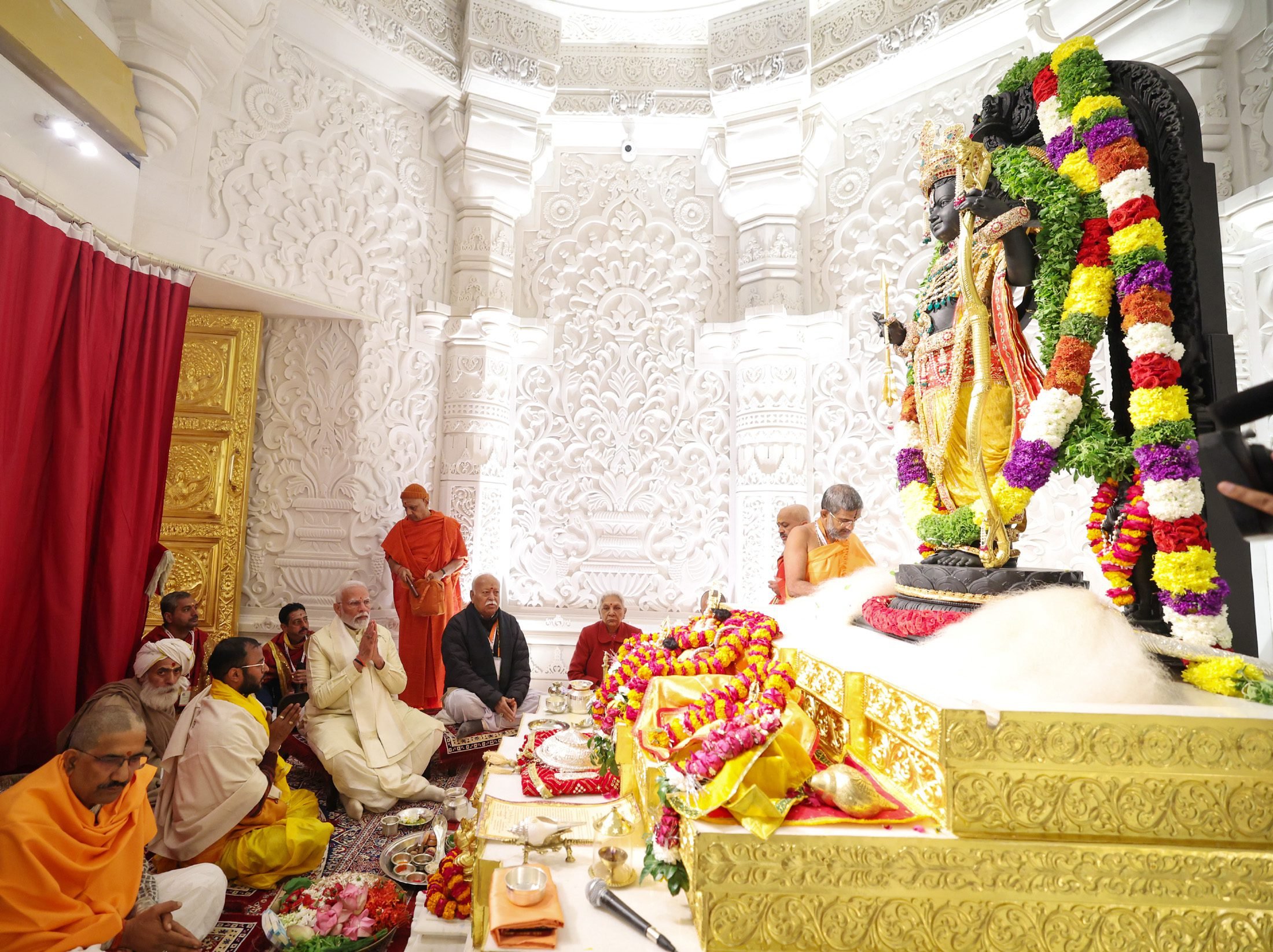


PM Narendra Modi seeking the blessings of Ram Lalla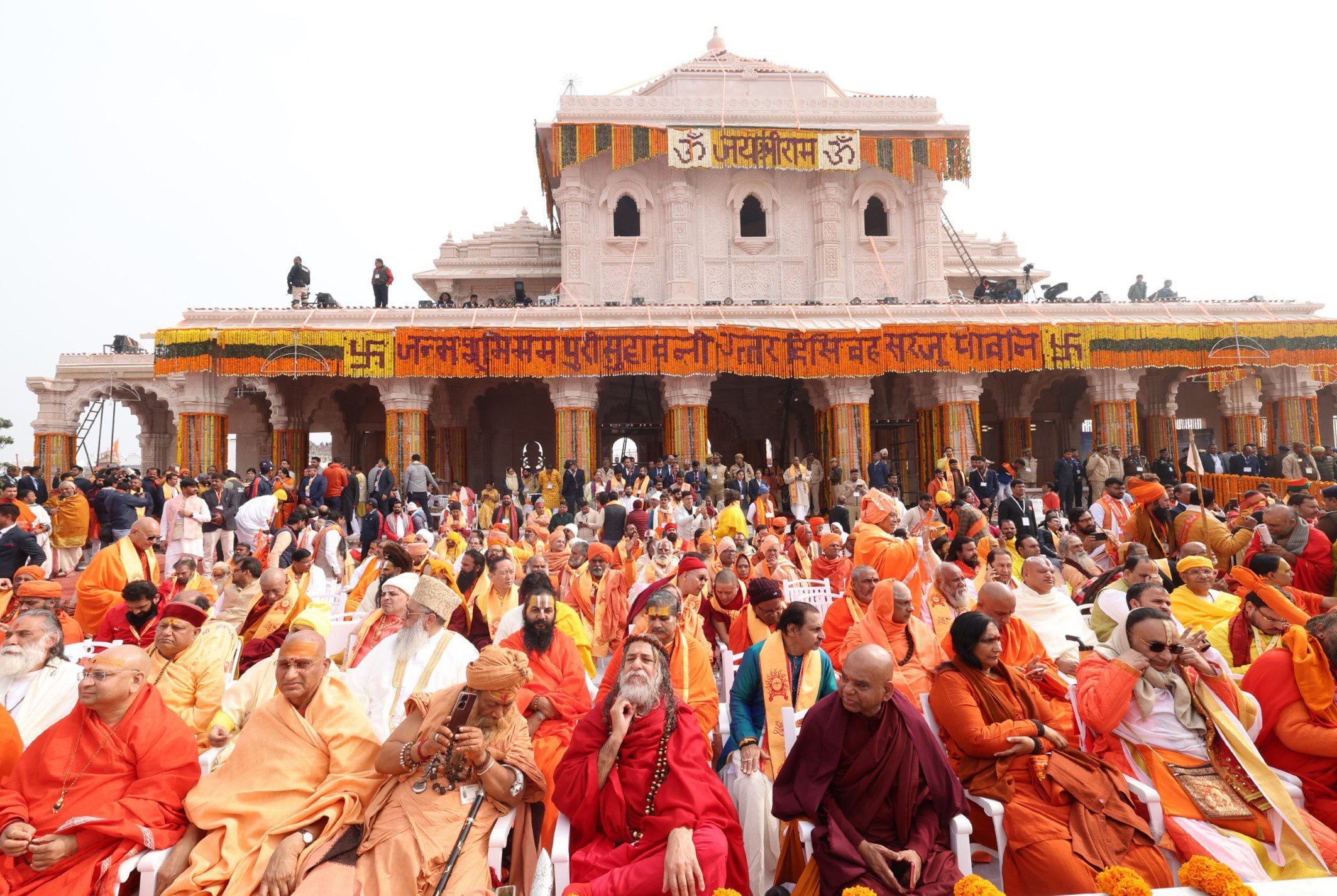
(Source: Twitter handle of home minister Amit Shah)
View this post on Instagram

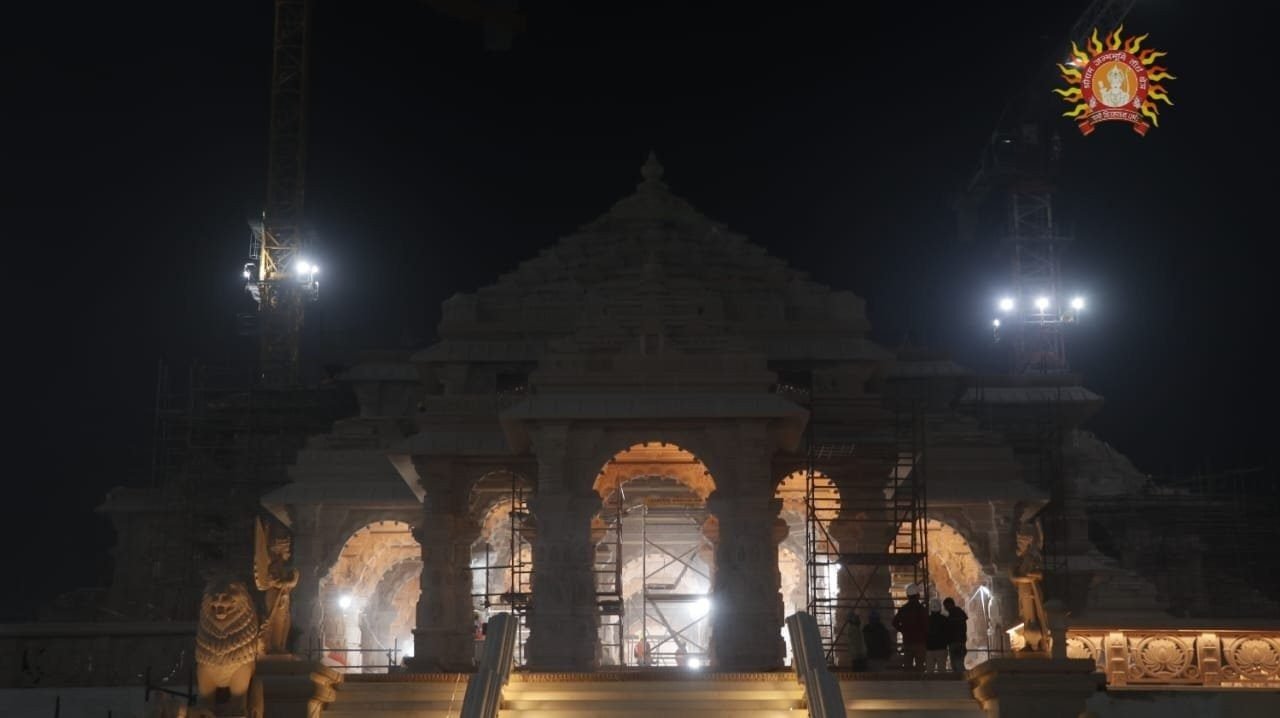
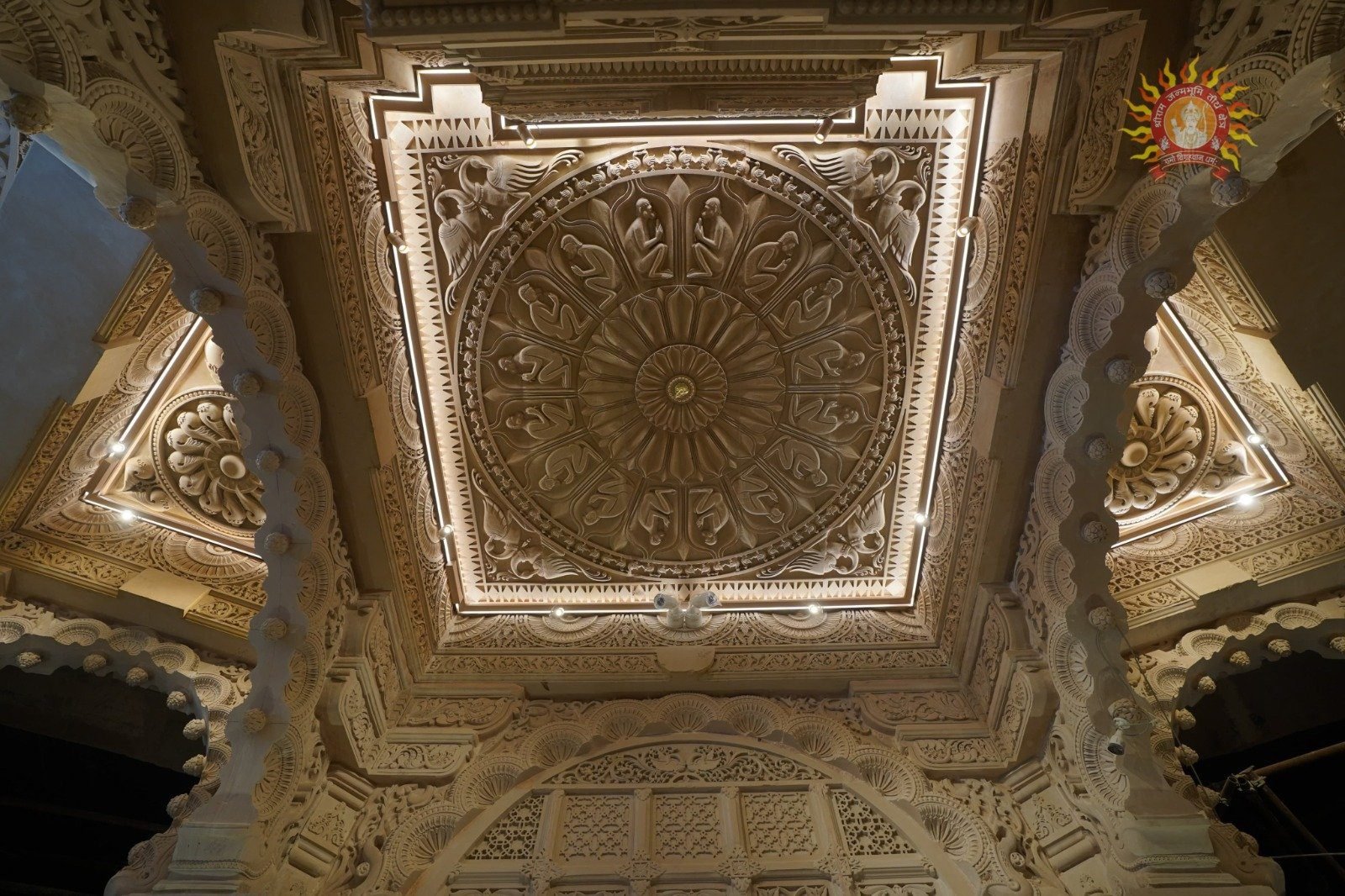
Source: Twitter/@DDUttarPradesh
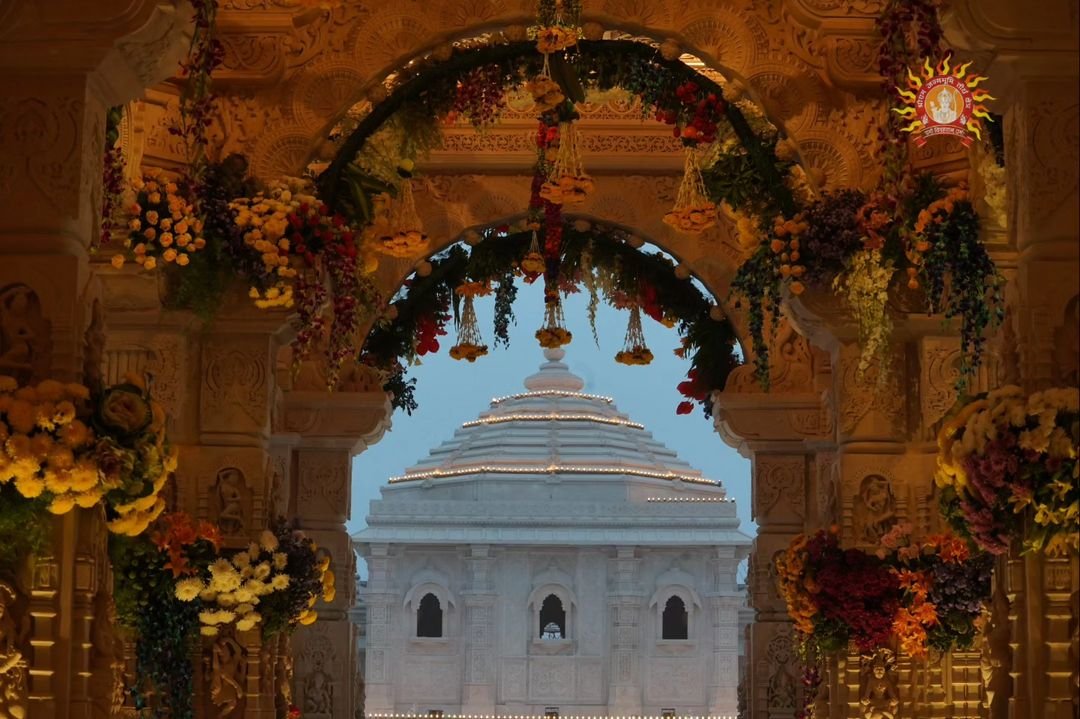

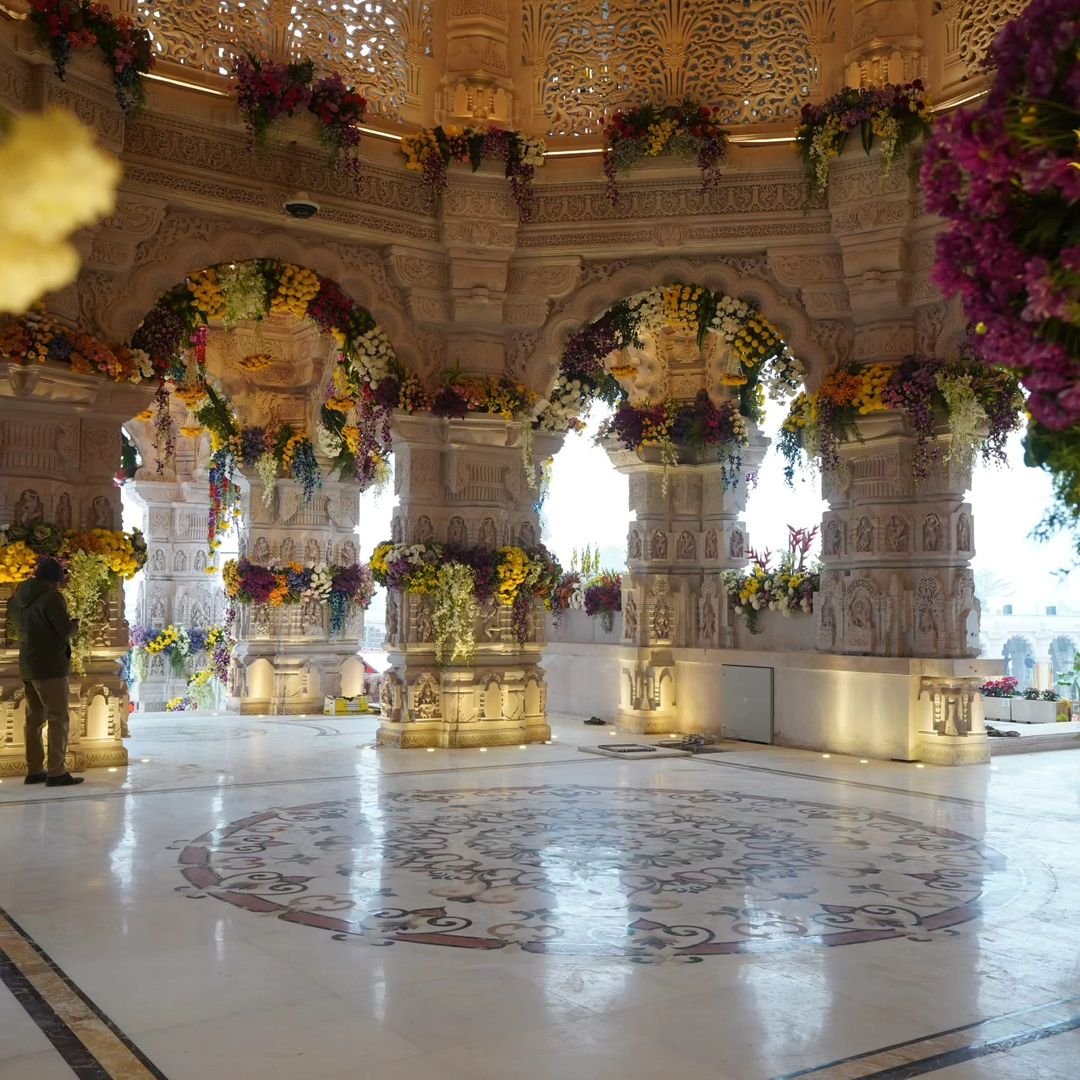

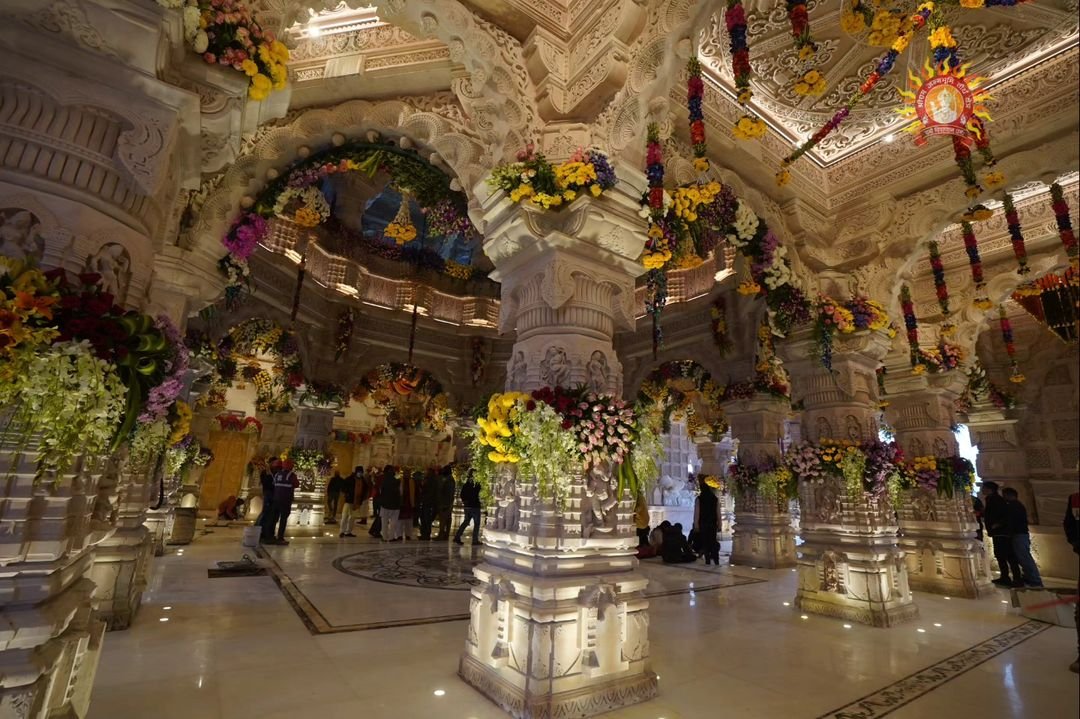

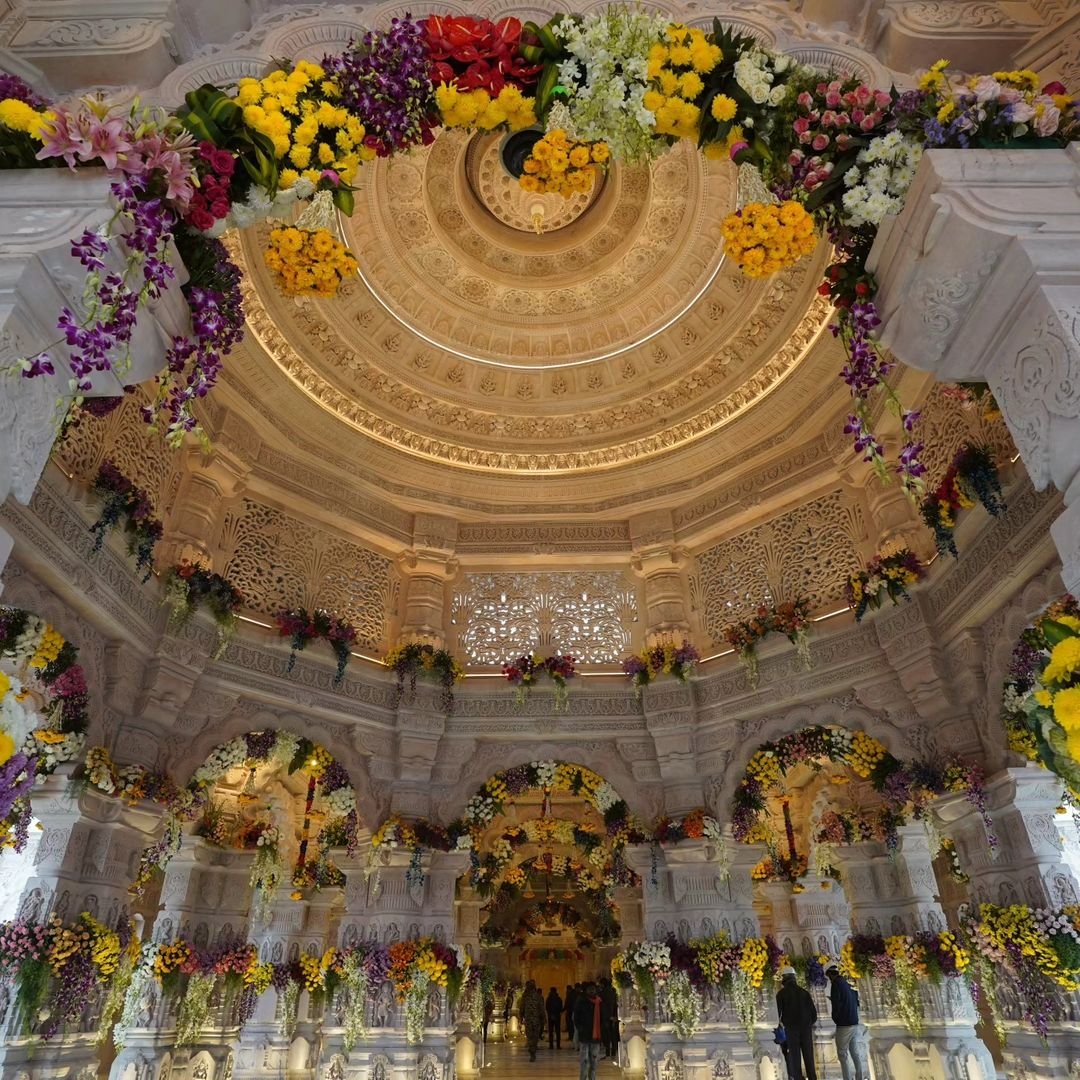
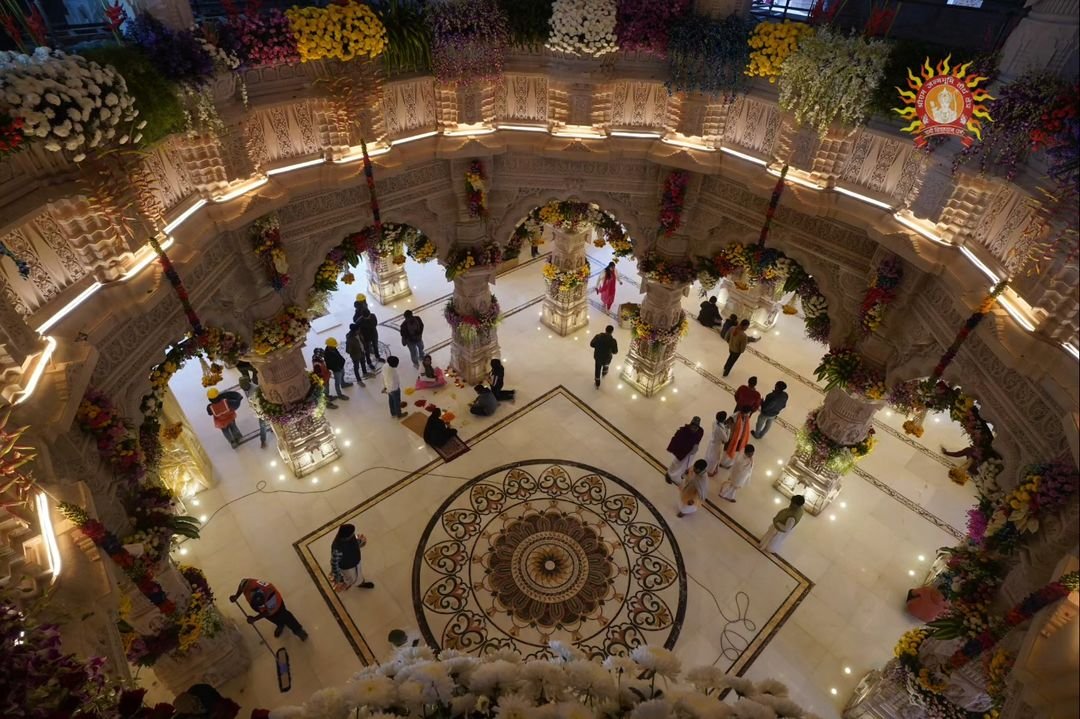
(Source: Instagram/shriramteerthkshetra)
Ayodhya Ram Mandir’ Gold-studded doors
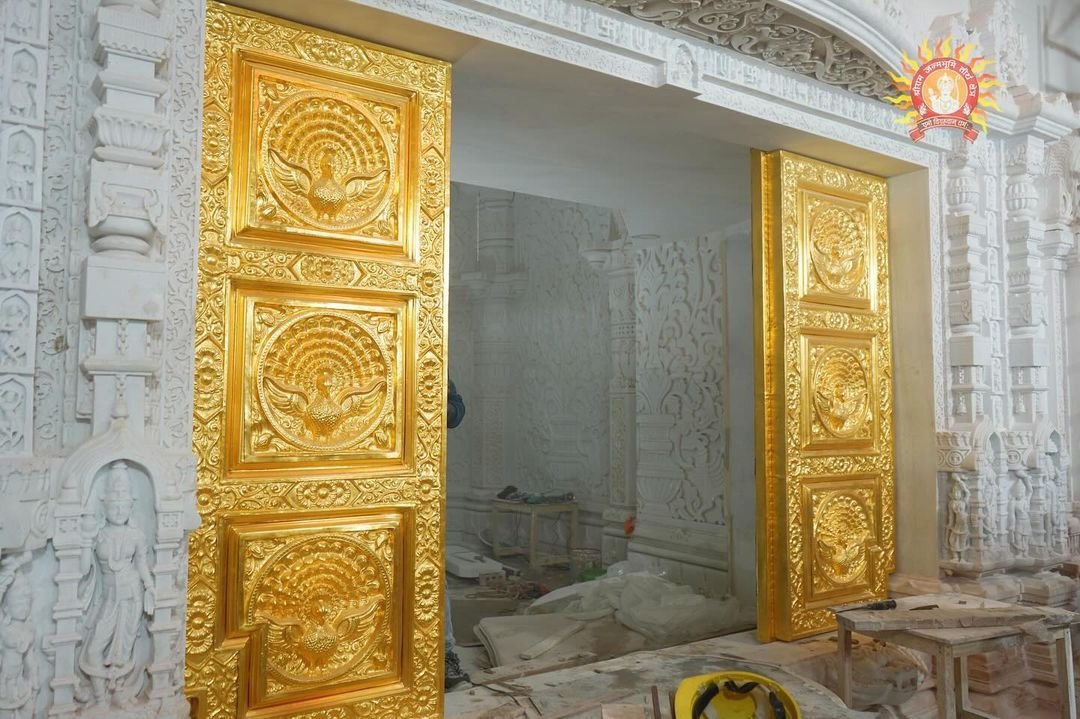
(All images, videos sourced from the instagram handle of Shri Ram Janmabhoomi Teerth Kshetra Trust)
News update
Ram Temple to have many small within premises: Champat Rai
April 22, 2024: The multipurpose area in the Ayodhya Ram Temple would have six additional temples, dedicated to deities such as Lord Shiva and Lord Hanuman. According to Shri Ram Janmabhoomi Teerth Kshetra Trust general-secretary Champat Rai, “the ‘Parkota’ will be multipurpose where 6 more temples will be built that is of lord Shankar, lord Surya, a ‘Garbhgriha’ and at two arms, temple of lord Hanuman and Ma Annapurna will be built… Temples of Maharishi Valmiki, Maharishi Vashishtha, Maharishi Vishwamitra, and Maharishi Agastya will also be built in the temple premises. Temples of Nishad Raj, Ma Shabri, Ma Ahilya and Jatayu will be built as well. The temple will have the capacity to accommodate 25,000 pilgrims at a time with all their baggage.”
Once completed, the temple would be able to accommodate 25,000 pilgrims at a time, Rai said on April 21.
Construction at Ram Temple set to resume from Feb 15
Plans are underway to resume the unfinished work at the Ayodhya ram temple from February 15, as the work of reassembling the machines installed at Ram Janmabhoomi complex has begun. Engineers engaged in the project said two tower cranes were being set up again on the western side of the temple while workers will be back to the site on February 15.
The 3,500 construction workers who were given a one month leave from January 15 due to the Pran-Pratisha (consecration) ceremony on January 22, are likely to get back to work to complete the pending construction.
FAQs
Who is the owner of the Ram Mandir land?
The Shri Ram Janmabhoomi Tirth Kshetra Trust is the owner of the Ram Mandir land.
Which company will be building the Ram Mandir?
L&T is building the Ram Mandir.
What is the significance of Ayodhya the city?
Situated on the banks of the Saryu river in the state of Uttar Pradesh in India, Ayodhya is defined as the premier among the six holy cities for the Hindus. The other five are Mathura, Haridwar, Kashi, Kanchi, and Ujjain.
How far is Ayodhya from Delhi?
Ayodhya is 636 km from Delhi.
How far is Ayodhya from Lucknow?
By the rail route, Ayodhya is 128 km from Lucknow.
How far is Ayodhya from Gorakhpur?
By the rail route, Ayodhya is 171 km from Gorakhpur.
How far is Ayodhya from Pragaygraj?
By the rail route, Ayodhya is 157 km from Prayagraj.
How far is Ayodhya from Kashi?
By the rail route, Ayodhya is 196 km from Varanasi.
| Got any questions or point of view on our article? We would love to hear from you. Write to our Editor-in-Chief Jhumur Ghosh at [email protected] |

An alumna of the Indian Institute of Mass Communication, Dhenkanal, Sunita Mishra brings over 16 years of expertise to the fields of legal matters, financial insights, and property market trends. Recognised for her ability to elucidate complex topics, her articles serve as a go-to resource for home buyers navigating intricate subjects. Through her extensive career, she has been associated with esteemed organisations like the Financial Express, Hindustan Times, Network18, All India Radio, and Business Standard.
In addition to her professional accomplishments, Sunita holds an MA degree in Sanskrit, with a specialisation in Indian Philosophy, from Delhi University. Outside of her work schedule, she likes to unwind by practising Yoga, and pursues her passion for travel.
[email protected]



